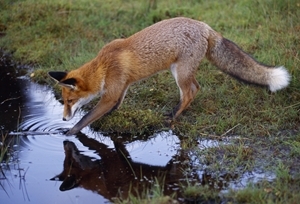Vulpes vulpes
 The fox is indigenous to all of mainland Britain and Ireland, where its fortunes have essentially been determined by man's activities. Factors resulting in high numbers include:
The fox is indigenous to all of mainland Britain and Ireland, where its fortunes have essentially been determined by man's activities. Factors resulting in high numbers include:
- Man's alteration of the habitat and thus of the fox's prey species;
- The elimination of natural predators (e.g. the wolf, lynx and golden eagle;
- The introduction of new prey species, such as the rabbit and pheasant;
- The provision of other new food resources, as in suburban areas.
More directly, man has sought in different circumstances to limit fox abundance through culling and to conserve populations for sport hunting.
In recent historic times, there have been major changes in these factors and there is no reason to believe that fox numbers are currently stable. In addition, there have been recent increases in range: to Anglesey, Holy Island and, at least temporarily to the Isle of Man and to parts of East Anglia, parts of the Pennines and eastern Scotland, where they were once very scarce.
The best estimate of the current British fox population is 240,000 adults in spring, to which a production of 425,000 cubs is added annually. For the population to remain stable, 425,000 foxes must therefore die each year. In both rural and urban areas, mortality caused by man predominates. Gamekeepers probably kill 70,000-80,000 annually. Additional culling by other interest groups is difficult to quantify. In urban areas, where 14% of foxes live, road traffic is the chief cause of death.
The number of foxes killed per square kilometre on shooting estates by gamekeepers has increased year-on-year since National Gamebag Census records began in 1961, in all regions of Britain. This could reflect changes in control methods, but ancillary data suggests that it reflects a regional increase in fox abundance, creating a larger influx of dispersing animals onto shooting estates. The rate of increase in fox bags has flattened off since about 1995.

Download Peter Thompson's essential 26-page book, featuring beautiful photography and detailed profiles of Britain's wildlife
Download FREE >